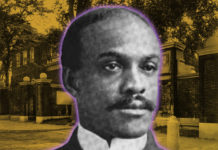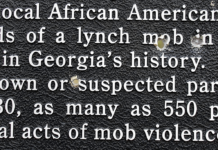In February of 1864, a British speech therapist named James Hunt published a paper in the United States, which he had delivered as a speech before the London Anthropological Society. The speech was a comprehensive, nauseating summary of the “science” that had been mustered in defense of the American institution of chattel slavery.
That “science,” which we now know to be – in the parlance of our times – bullshit, ranged from phrenology to chicanery to fabrication. In one passage, Hunt discusses the culture of enslaved African-American people:
The family relations are weak; the husband or father is little concerned … in short, the great curve of human development, and its backward direction, appear to be sufficiently extended to appreciate the differences characterising the Negro race opposed to our race … in any case, an honorable mediocrity is his inheritance.
Slavery’s enthusiasts glommed onto this research. In an infamous speech, South Carolina Senator James Henry Hammond said:
In all social systems there must be a class to do the menial duties, to perform the drudgery of life. That is, a class requiring but a low order of intellect and but little skill … Fortunately for the South, she found a race adapted to that purpose to her hand … We use them for our purpose, and call them slaves.
Despite a century and a half of putative progress, some of these ideas persist, most shockingly among the global commentariat elite. Charles Murray propagates pseudoscience on the differential capabilities of the “races.” Writers like Andrew Sullivan and Steven Pinker echo his work, while mainstream rightwing publications stoke the flames under the guise of asking provocative questions.
These ideas are poisonous enough when posited as philosophical precepts, but they are lethal when they find their way into public policy discourse. That’s why this recent article from the Thomas B. Fordham Institute, a think tank that studies public education, was so horrifying. In the piece, a researcher searches for ways to describe racial differences in standardized test scores:
There are myriad reasons for these score differences, and many concern commonly cited correlates of achievement that NAEP tracks, such as family income, parent education level, and the primary language that a child is exposed to at birth … There are, however, at least two other variables to consider: marriage rates and parent expectations. Combined with the other correlates … these two variables paint a more coherent picture.
Change just a few words in that passage, and it would fit capably in Hunt’s summation of nineteenth century race literature: prejudiced conjecture, masquerading as analysis, wrapped in today’s preferred data-driven rhetoric. Perhaps most damagingly, this sort of work looks for any explanation for racist outcomes except for racism itself.
It would be dangerous enough if these ideas were being espoused by laymen, but Fordham is a well-funded think-tank, in the business of influencing federal and state education policy. There is a well-trod path from their lips to lawmakers’ ears, and the organization’s leadership wields disproportionate influence over the policies that shape the lives of black and brown children.
The author of the piece cited above admits that his research demonstrates correlation, and not causation, but that concession only makes his argument worse. In effect, this research retrofits two independent variables to fit testing outcomes. One of those variables – “marriage rates” – comes from a cultural judgment, which directly echoes slavery apologists’ claims about cultural inferiority and family structure.
The other variable, “parent expectations,” is based on a pseudoscientific analysis of perceptions, which are assessed by asking whether parents “expect” their children to receive a four-year college degree. This is a bad, and in this case, irresponsible, way to describe a social science phenomenon. Those perceptions are inevitably driven by this country’s history of racism. If you asked the same parents whether they “expect” the police to treat their children with dignity, their answers would probably reflect a similar dearth of “expectations.” If someone punches you in the face for the ten minutes, then pauses to ask if you expect the beatings to continue, it’s hard to blame your “expectations” for the assault.
This dalliance in racist pseudoscience is not new for the Thomas B. Fordham Institute. America’s most notorious race “scientist” is frequently invited and cited by their spokespeople. Their commentary on family structure has been a theme for many years, as has been their insistence on blaming the culture of poor communities for disparate disciplinary outcomes for children of color. If the propagation of these ideas is predicated on ignorance, that ignorance is willful; critics, including myself, have labored to demonstrate the flaws in their logic and scientific methods. All of this work perpetuates institutional racism, irrespective of whether any of the individuals propagating these arguments express individual racial prejudices.
It is impossible to separate the racist outcomes we observe from the racist inputs our systems protect, and it is disgusting to blame those outcomes on the very people who must suffer from them. If someone went around poisoning the water in communities, we would never blame those people for not developing immunity; we would try to find the assholes who were spreading the poison.
And yet, from the time European colonists set foot on American soil, racism has been our most persistent and potent poison. Much like today’s right-wing policy experts use junk science to distract us from that poison, so did those early Americans use the crappy research of their day to explain their infatuation with slavery.
It would have been much simpler and honest for the apologists to admit that they benefited immensely from slavery’s perpetuation. Not dissimilarly, today’s privileged people benefit from the maintenance of racial disparities, whether they personally strive to uphold those inequities or not. And so the cycle persists. One of the great magic tricks of racism is that its most pernicious manifestations are of the most banal sort: cultivated not in the dingy labs of deranged madmen, but in the quiet cubicles of supposedly dignified institutions.










